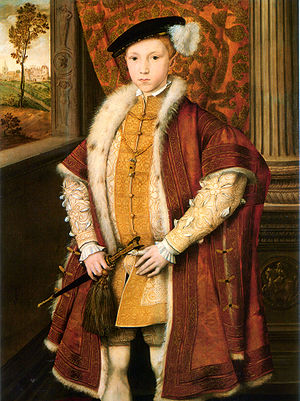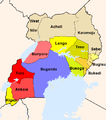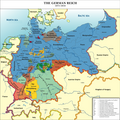Portal:Monarchy
Portal maintenance status: (June 2018)
automated editing software. Learn how to update the maintenance information here . |
The Monarchy Portal  A monarchy is a form of government in which a person, the monarch, is head of state for life or until abdication. The political legitimacy and authority of the monarch may vary from restricted and largely symbolic (constitutional monarchy), to fully autocratic (absolute monarchy), and can span across executive, legislative, and judicial domains. The succession of monarchs has mostly been hereditary, often building dynasties. However, elective and self-proclaimed monarchies have also often occurred throughout history. Aristocrats, though not inherent to monarchies, often serve as the pool of persons from which the monarch is chosen, and to fill the constituting institutions (e.g. diet and court), giving many monarchies oligarchic elements. Monarchs can carry various titles such as emperor, empress, king, and queen. Monarchies can form federations, personal unions and realms with vassals through personal association with the monarch, which is a common reason for monarchs carrying several titles. Monarchies were the most common form of government until the 20th century, by which time republics had replaced many monarchies. Today forty-three sovereign nations in the world have a monarch, including fifteen Commonwealth realms that share King Charles III as their head of state. Other than that, there is a range of sub-national monarchical entities. Most of the modern monarchies are constitutional monarchies, retaining under a constitution unique legal and ceremonial roles for the monarch, exercising limited or no political power, similar to heads of state in a parliamentary republic. (Full article...)
| ||||||||||||||||||||||||||||||||||||||||||||||||
 |
| Credit: David Iliff |
The
Did you know (auto-generated)
More Did you know...
- ... that Holy Roman Emperor Maximilian I commissioned the Triumphal Arch (pictured), a monumental woodcut print over 3½ m (11½ ft) tall and nearly 3 m (10 ft) wide printed from 192 separate wood blocks?
- ... that Persian rulein circa 522 BCE?
- ... that makers of protégésof the royals?
More did you know facts |
 Good articles - load new batch
Good articles - load new batch
-
Image 1Shishman dynasty. (Full article...)
-
Image 2king of Babylon in 626 BC to his death in 605 BC. Though initially only aimed at restoring and securing the independence of Babylonia, Nabopolassar's uprising against the Neo-Assyrian Empire, which had ruled Babylonia for more than a century, eventually led to the complete destruction of the Assyrian Empire and the rise of the Neo-Babylonian Empire in its place. (Full article...)Image 3Pressburg (now Bratislava in Slovakia). Ladislaus, who died on 14 January 1163, was succeeded by Stephen's younger uncle and namesake, Stephen IV, without resistance, but his rule was unpopular. The young Stephen defeated his uncle on 19 June 1163 and expelled him from Hungary.)
Stephen IV attempted to regain his throne with Emperor Manuel I's support, but the latter made peace with Stephen III. He agreed to send his younger brother, Béla, to Constantinople and to allow the Byzantines to seize Béla's duchy, which included Croatia, Dalmatia and Sirmium. In an attempt to recapture these territories, Stephen III waged wars against the Byzantine Empire between 1164 and 1167, but could not defeat the Byzantines. (Full article...Image 4bishop of Eger or Várad (Oradea, Romania) in the early 1090s. The dying King Ladislaus preferred Álmos to Coloman when nominating his heir in early 1095. Coloman fled from Hungary but returned around 19 July 1095 when his uncle died. He was crowned in early 1096; the circumstances of his accession to the throne are unknown. He granted the Hungarian Duchy—one-third of the Kingdom of Hungary—to Álmos.)
In the year of Coloman's coronation, at least five large groups of crusaders arrived in Hungary on their way to the Holy Land. He annihilated the bands who were entering his kingdom unauthorized or pillaging the countryside, but the main crusader army crossed Hungary without incident. He invaded Croatia in 1097, defeating its last native king Petar Snačić. Consequently, he was crowned king of Croatia in 1102. According to the late 14th-century Pacta conventa (the authenticity of which is not universally accepted by scholars), he was only crowned after having ratified a treaty with the leaders of the Croatian nobility. For centuries thereafter, the Hungarian monarchs were also the kings of Croatia. (Full article...Image 5Arabic: عبد الله بن فودي, romanized: Abd Allah ibn Fudi; ca. 1766–1828), was a prominent Islamic scholar, jurist, poet and theologian, and the first Amir of Gwandu (r. 1812–1828) and first Grand Vizier of Sokoto. His brother, Usman dan Fodio (1754–1817) was the founder of the Sokoto Caliphate. Usman, being more of a scholar than politician, delegated the practical regency of the western part of his empire to Abdullahi and the eastern part to his son Muhammed Bello, who later became the Sultan of Sokoto after his father. (Full article...)Image 6Persian Achaemenid Empire in the region. The only known surviving reference which points to there being a ruler by this name in Babylon is the Uruk King List, which records rulers of Babylon from the 7th to 3rd centuries BC. In this list, the rule of Darius III (r. 336–330 BC), the last Achaemenid king, is immediately preceded by a fragmentary reference to Nidin-Bel. (Full article...)Image 7Battle of Poitiers. He died campaigning in France in 1360. Throughout his career, he was closely associated with William de Bohun, 1st Earl of Northampton, who was his brother-in-law. (Full article...)Image 8Vukašin, was co-ruler with Serbian Tsar Stefan Uroš V, whose reign was characterised by weakening central authority and the gradual disintegration of the Serbian Empire. Vukašin's holdings included lands in north-western Macedonia and Kosovo. In 1370 or 1371, he crowned Marko "young king"; this title included the possibility that Marko would succeed the childless Uroš on the Serbian throne.)
On 26 September 1371, Vukašin was killed and his forces defeated in the Battle of Maritsa. About two months later, Tsar Uroš died. This formally made Marko the king of the Serbian land; however, Serbian noblemen, who had become effectively independent from the central authority, did not even consider to recognise him as their supreme ruler. Sometime after 1371, he became an Ottoman vassal; by 1377, significant portions of the territory he inherited from Vukašin were seized by other noblemen. King Marko, in reality, came to be a regional lord who ruled over a relatively small territory in western Macedonia. He funded the construction of the Monastery of Saint Demetrius near Skopje (better known as Marko's Monastery), which was completed in 1376. Later, Marko became an Ottoman vassal and died on 17 May 1395, fighting against the Wallachians in the Battle of Rovine. (Full article...Image 9absolute monarch from 1768 until his death. Of unclear origins, Šćepan became the ruler of Montenegro through a rumour that he was in fact the deposed Russian emperor Peter III, who had died several years before Šćepan surfaced in the Balkans.)
Šćepan arrived in Montenegro in the autumn of 1766. Whether Šćepan was his real name is unknown, as is the reason for the epithet Mali. Who started the rumour that Šćepan was Peter and why is also unclear. Šćepan himself never formally proclaimed himself to be Peter, but never denied it either. Throughout 1767, he offered vague hints that he was the dead emperor, and as time went on, most of Montenegro became convinced of his supposed identity. Although Montenegro's legitimate ruler, Prince-Bishop Sava, who had met the real Peter and had received word from the Russian ambassador in Constantinople that Peter was dead, attempted to expose Šćepan, most Montenegrins continued to believe the rumours. In 1767, Šćepan was proclaimed as the country's ruler, and in February 1768, Sava was sidelined and confined to his monastery. Šćepan subsequently assumed the powers of an absolute monarch. (Full article...Image 10statue of Kamehameha I and the rebuilding of ʻIolani Palace, were expensive endeavors but are popular tourist attractions today. (Full article...)Image 11Battle of Cape St Vincent. Shortly after that battle, Nelson took part in the Battle of Santa Cruz de Tenerife, where the attack failed and he lost his right arm, forcing him to return to England to recuperate. The following year he won a decisive victory over the French at the Battle of the Nile and remained in the Mediterranean to support the Kingdom of Naples against a French invasion. (Full article...)Image 12Muirchertach Mac Lochlainn, High King of Ireland, Mac Murchada was beset by his enemies. At this critical point of his reign, Mac Murchada lost the support of the Dubliners, which contributed to his expulsion from Ireland that year. Not long afterwards, however, he made his return with significant military assistance from mercenary English adventurers. In the latter half of 1170, Dublin itself fell to the combined forces of Mac Murchada and the powerful English magnate Richard de Clare, Earl of Pembroke. (Full article...)Image 13Eastern Roman emperor Leo I.)
Aegidius repeatedly threatened to invade Italy and dethrone Libius Severus, but never actually launched such an invasion; historians have suggested he was unwilling to launch an invasion due to the pressure of the Visigoths, or else because it would leave Gaul exposed. Aegidius launched several campaigns against the Visigoths and the Burgundians, recapturing Lyon from the Burgundians in 458, and routing the Visigoths at the Battle of Orleans. He died suddenly after a major victory against the Visigoths; ancient historians say that he was assassinated, but do not give the name of the assassin, whereas modern historians believe it is possible that he died a natural death. (Full article...Image 14Basil the Macedonian, who a year later would usurp the throne for himself and install his own dynasty on the Byzantine throne. (Full article...)Image 15Jabal Ajlun regions. By then, however, Ali Bey had been killed, the Ottomans entered into a truce with the Russians, and the Ottoman imperial government felt secure enough to check Zahir's power. The Ottoman Navy attacked his Acre stronghold in the summer of 1775 and he was killed outside of its walls shortly after. (Full article...)Featured portrait

Edward VI of England Credit: Unknown, probably of the Flemish SchoolA portrait of
Tudor dynasty and England's first ruler who was Protestant at the time of his ascension to the throne. Edward's entire rule was mediated through a council of regency. He died at the age of 15 in 1553.Read moreSelected quote
Courage! I have shown it for years; think you I shall lose it at the moment when my sufferings are to end? — Marie Antoinette, Responding to the priest who had accompanied her to the foot of the guillotine, who had whispered, "This is the moment, Madame, to arm yourself with courage."Related portals
General images - load new batch
The following are images from various monarchy-related articles on Wikipedia.-
Image 2Waikato, the homeland of the Māori kings (from Non-sovereign monarchy)
-
Image 3Ramesses II (r. 1279–1213 BC), the third Pharaoh of the Nineteenth Dynasty of Egypt (from Monarch)
-
Image 5Contemporary European monarchies by type of succession )
-
Image 8The administrative divisions of the British Protectorate of Uganda, including five of today's six kingdoms (from Non-sovereign monarchy)
-
Image 9The islands that make up Wallis and Futuna (from Non-sovereign monarchy)
-
Image 10Dinzulu kaCetshwayo, the last king of an independent Zulu state, in 1883 (from Non-sovereign monarchy)
-
Image 12Subdivisions of the United Arab Emirates (from Non-sovereign monarchy)
-
Image 13A map of Europe exhibiting the continent's monarchies (red) and republics (blue) (from Monarch)
-
Image 14Emperor of Brazil, by Delfim da Câmara (from Monarch)
-
Image 15From left to right, JapaneseEmpress Nagako, 1959 (from Monarch)
-
Image 16British India and the princely states within the Indian Empire. The princely states (in yellow) were sovereign territories of Indian princes who were practically suzerain to the Emperor of India, who was concurrently the British monarch, whose territories were called British India (in pink) and occupied a vast portion of the empire. (from Non-sovereign monarchy)
-
Image 17Photograph of Tsar Alexander II, 1878–81 (from Absolute monarchy)
-
Image 18The constituent states of the German Empire (a federal monarchy). Various states were formally suzerain to the emperor, whose government retained authority over some policy areas throughout the federation, and was concurrently King of Prussia, the empire's largest state. (from Non-sovereign monarchy)
-
Image 19Postcard from 1908 showing nineteen of the world's reigning monarchs: (left to right)King Alfonso XIII of Spain. (from Monarch)
-
Image 20Hawaii (from Monarch)
-
Image 22The Nine Sovereigns atKing Frederik VIII of Denmark. (from Monarch)
-
Image 23Sri Lankan King Devanampiya Tissa, Queen consort Anula, and Prince Uththiya, c. 307 BC (from Monarch)
-
Image 24Emperoroldest continuous hereditary monarchy in the world. (from Hereditary monarchy)
-
Image 26Elizabeth II was the monarch of independent countries in Europe, Asia, Africa, Oceania and the Americas. (from Monarch)
-
Image 27Emperor of Haiti, 1804 (from Monarch)
Featured content
Topics
- Monarch
- Imperial, royal and noble ranks
- List of current sovereign monarchs
- List of current non-sovereign monarchs
- List of monarchy referendums
Type Topics Titles Current Africa Asia Europe - Andorra
- Belgium
- Denmark
- Liechtenstein
- Luxembourg
- Monaco
- Netherlands
- Norway
- Spain
- Sweden
- Vatican City (Holy See)
Oceania Commonwealth realms Former Africa Americas Asia - Afghanistan
- Asir
- Bengal
- Bukhara
- Burma
- Cebu
- Chehab
- China
- Dapitan
- Hejaz
- Indonesia
- Iran (Qajar)
- Iraq
- Jabal Shammar
- Kandy (Sri Lanka)
- Kathiri
- Khiva
- Korea
- Kumul
- Kurdistan
- Laos
- Maguindanao
- Mahra
- Maldives
- Manchukuo
- Mongolia
- Najran
- Nepal
- Qu'aiti
- Ryukyu
- Sarawak
- Shan
- Sikkim
- Sip Song Chau Tai
- Sulu
- Syria
- Tibet
- Taiwan
- Upper Asir
- Upper Yafa
- Vietnam
- Yemen (South Yemen)
Europe - Albania
- Aragon
- Asturias
- Austria
- Austria-Hungary
- Bavaria
- Bosnia
- Brittany
- Bulgaria
- Crimea
- Cilicia
- Corsica
- Cyprus
- Finland
- France
- Galicia
- Georgia
- Germany
- Greece
- Granada
- Hanover
- Hungary
- Iceland
- Imereti
- Ireland
- Italy
- Kartli-Kakheti
- Lithuania
- Majorca
- Man
- Moldavia
- Montenegro
- Navarre
- Neuchâtel
- Ottoman Empire
- Papal States
- Piedmont-Sardinia
- Poland–Lithuania
- Portugal
- Prussia
- Romania
- Russia
- Samos
- Saxony
- Savoy
- Scotland
- Serbia
- Tavolara
- Two Sicilies
- Tuscany
- Ukraine
- United Baltic Duchy
- Yugoslavia
- Valencia
- Württemberg
Oceania Commonwealth realms Categories
WikiProjects
- WikiProject Royalty and Nobility
- WikiProject Biography
- WikiProject Commonwealth realms
- WikiProject Politics
Associated Wikimedia
The following Wikimedia Foundation sister projects provide more on this subject:
-
Commons
Free media repository -
Wikibooks
Free textbooks and manuals -
Wikidata
Free knowledge base -
Wikinews
Free-content news -
Wikiquote
Collection of quotations -
Wikisource
Free-content library -
Wikiversity
Free learning tools -
Wiktionary
Dictionary and thesaurus
Discover Wikipedia using portals























































